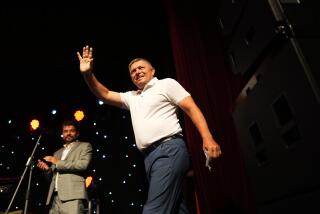Czechs, Slovaks Say Farewell to Unity--Warily
- Share via
BRATISLAVA, Slovakia — The independent state of Slovakia emerged to crackling fireworks and bittersweet toasts at the stroke of midnight heralding the New Year here, a celebration muted by the passing of its 74-year-old parent federation.
Czechoslovakia ceased to exist with the arrival of 1993, an officially arranged dissolution that has left its more than 15 million survivors--roughly 10 million Czechs and 5 million Slovaks--more fearful of their future than jubilant over newfound freedom.
The mixed feelings with which Slovaks have embraced the sovereignty that eluded them for a millennium was evident in the relatively meager crowd of 10,000 revelers who gathered at the Square of the Slovak National Uprising in this new capital to wave flags and pop bottles of bubbly.
Older Slovaks with long grudges against the Czechs, whom they accuse of arrogance and domineering rule, were joined by youthful radicals draped in the new Slovak tricolor.
“We will have less in the beginning, but it will be ours,” pensioner Emil Orlik said as he watched the smoky fireworks, summing up the determinedly hopeful sentiment of the crowd.
While most of the revelers expressed goodwill toward the Czech partners from whom they are now divorced, ardent nationalists also prowled the crowd to flaunt provocative symbols. A tiny black coffin stood on the square bearing the federal flag and a black banner announcing the “death of the subjugation of Slovakia.”
“We were transformed into a colony by the Czechs,” insisted Sidonia Fehervary, 41, a biochemist hoisting a picture of Josef Tiso, the Slovak priest who served as president during the country’s collaboration with Nazi Germany during World War II. “With independence, I may be poor, but I’ll be Slovak.”
Outside the central cluster of independence supporters, the atmosphere was one more of mourning than celebration. “We were two states that each had something, but together we were so much more,” said a wistful Miroslava Cabadojova, an 18-year-old waitress.
At a Danube River monument marking the October, 1918, founding of the Czechoslovak federation, flickering candles and dozens of floral tributes testified to the sense of loss felt by many.
Even Slovak Prime Minister Vladimir Meciar, a populist blamed for forcing what many see as an ill-advised split, conceded that his new nation faces a rough road to prosperity and that many Slovaks embark on independence with wounded feelings and heavy hearts.
Asked at a news conference whether he had any regrets about independence, Meciar related a chilling comment by one of his legal advisers. The assistant, a Czech, told Meciar that working out the mechanics of Czechoslovakia’s demise gave him the feeling he was building a crematory in which his own relatives would be burned.
“The question of feelings in this is irrelevant,” Meciar stated dispassionately. “The question is whether any other solution was possible. If we wanted to keep the peace, there was no other way.”
Czech Prime Minister Vaclav Klaus similarly dismissed the death of Czechoslovakia as the only way forward for the federation’s people. “I am fully convinced there was no other solution,” Klaus said in a televised debate with Meciar earlier this week. “It makes me sad . . . but clearly (a united Czechoslovakia) was not meant to be.”
While the Czech lands are better positioned to attract foreign investment and quickly restructure their economy along Western lines, most of the citizens of the truncated country ruled from Prague acknowledge that the disruption of normal Czech-Slovak trade and transport will have negative repercussions for both sides. Trade turnover between the two republics is estimated at $5 billion each year.
“Now we have to fight for our place in the sun, and it won’t be easy,” Klaus said in a rare public acknowledgment that his fellow Czechs also face an uncertain future.
Those openly doubtful about the wisdom of dividing what was one of Eastern Europe’s more prosperous countries point out that the 5 million Slovaks suffer 12% unemployment--three times that of the Czechs--and host the bulk of the former federation’s antiquated heavy industries, including massive munitions works.
Opinion polls in both parts of the defunct federation regularly showed a majority supported continued unity. But both Meciar and Klaus worked to prevent a popular vote on the issue, the former for fear that a failed referendum would temper the nationalist fever he has raised and the latter because Czech pragmatists view union with Slovakia as an economic drain.
Dual citizenship questions are still being decided by both leaderships, but the republics agreed in one of dozens of pre-divorce compacts that all living within their borders will be granted passports and civil rights without regard to nationality.
One measure, however, of the varying degrees of security felt by the people now forced to choose sides is the application by 30,000 residents of Slovakia for citizenship in the Czech Republic, according to a report last week in the Lidove Noviny newspaper of Prague.
Many worry that creating two ethnic states out of one political federation is a formula for disaster. The view that “dividing Czechoslovakia along ethnic principles will not affect the stability of Central Europe is a historical naivete,” Jan Urban, a leader of the Civic Forum movement that engineered the 1989 “Velvet Revolution,” wrote this week in the Prague Post.
Urban warned that states defined by ethnicity will naturally intimidate minority peoples and pose the risk of nationalist conflicts as the societies are confronted with economic hardships. Slovakia’s 560,000 ethnic Hungarians have quietly expressed fears of repression in this new state.
Despite recurring complaints that the federation was divided without popular consent, politicians on both sides insist that the breakup was the only means of preventing the kind of escalating violence now racking the remnants of Eastern Europe’s two other former federations, the Soviet Union and Yugoslavia.
After a June election endorsed markedly different programs for post-Communist restructuring of the two republics, the Prague and Bratislava governments negotiated an amicable division of property on the 2-to-1 ratio of Czechs to Slovaks. Immovable objects, like government buildings, revert to the republic where they were built; federal services like the army have been divided and redeployed. Both republics will continue to use the Czech crown as currency for six months.
Czechs and Slovaks were joined in 1918, after the World War I defeat of the Austro-Hungarian Empire that ruled them for centuries.
More to Read
Sign up for Essential California
The most important California stories and recommendations in your inbox every morning.
You may occasionally receive promotional content from the Los Angeles Times.










